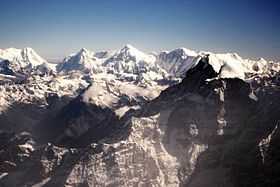Gauri Sankar
| Gauri Sankar | |
|---|---|
 Gauri Shankar (right) | |
| Elevation | 7,134 m (23,406 ft)[1] |
| Prominence | 1,709 m (5,607 ft)[2] |
| Listing | Ultra |
| Translation | The Goddess and her Consort (Sanskrit) |
| Location | |
 Gauri Sankar | |
| Location | Nepal - China (Tibet) |
| Range | Rolwaling Himal |
| Coordinates | 27°59′N 86°20′E / 27.983°N 86.333°ECoordinates: 27°59′N 86°20′E / 27.983°N 86.333°E[3] |
| Climbing | |
| First ascent | May 8, 1979 by John Roskelley and Dorje Sherpa |
| Easiest route | snow/ice climb |
Gauri Sankar (also Gauri Shankar or Gaurishankar; Devanagari गौरी शंकर; Tibetan: Jomo Tseringma;) is a mountain in the Himalayas, the second highest peak of the Rolwaling Himal, behind Melungtse (7,181m). The name comes from Sanskrit for the Goddess (Gauri) and her Consort (Shankar), denoting the sacred regard to which is afforded it by the peoples of Tibet and Nepal.
Location
Gauri Sankar lies near the western edge of the Rolwaling Himal, about 100 kilometres (62 mi) northeast of Kathmandu. (It is almost directly between Kathmandu and Mount Everest, and is visible from Kathmandu.) To the west of the peak lies the valley of the Bhote Kosi, the western boundary of the Rolwaling Himal. To the north lies the Menlung Chu, which separates it from its sister peak Menlungtse. To the south lies the Rolwaling Chu, which leads up to the Tesi Lapcha pass, giving access to the Khumbu region.[4] It is in Dolakha District.
Notable features
The mountain has two summits, the northern (higher) summit being called Shankar (a manifestation of Shiva) and the southern summit being called Gauri (a manifestation of Shiva's consort). It rises dramatically above the Bhote Kosi only 5 km away,[5][6] and is protected on all sides by steep faces and long, corniced ridges.[4][5]
Climbing history
The first attempts to climb Gauri Sankar were made in the 1950s and 1960s but weather, avalanches and difficult ice faces defeated all parties.[3] From 1965 until 1979, the mountain was officially closed for climbing. When permission was finally granted in 1979, an American-Nepalese expedition finally managed to gain the top, via the West Face. This was a route of extreme technical difficulty. The permit from the Nepalese Ministry of Tourism stipulated that the summit could only be reached if an equal number of climbers from both nations were on the summit team. John Roskelley and Dorje Sherpa fulfilled that obligation.[4]
In the same year, a British-Nepalese expedition climbed the long and difficult Southwest Ridge to the south summit (7010m). Though they did not make the long additional traverse to the main summit, their climb was a significant achievement in itself.[3][4]
In 1983 Gauri Shankar was reached again by Slovenian team.[7] The main summit (7181m) was reached on November the first by Slavko Cankar[7] (the leader of expedition), Bojan Šrot and Smiljan Smodiš, and three days later by Aco Pepevnik and Jože Zupan. They climbed the left side of the South Face to reach the Southwest Ridge.
The Himalayan Index lists only two additional ascents of the main summit of Gauri Sankar.[7] The second ascent was made in the spring of 1984 by Wyman Culbreth and Ang Kami Sherpa, via a new route on a ridge on the southwest face. The third ascent (and the first winter ascent), in January 1986, was by South Korean Choi Han-Jo and Ang Kami Sherpa.[8]
References
- ↑ http://www.peakbagger.com/peak.aspx?pid=10641
- ↑ from peakbagger.com. Sources vary widely on this peak's prominence. Peaklist.org gives a prominence of 1,600 m, which appears to be based on a peak elevation of 7,146 m.
- ↑ 3.0 3.1 3.2 Jill Neate, High Asia: An Illustrated History of the 7000 Metre Peaks, ISBN 0-89886-238-8
- ↑ 4.0 4.1 4.2 4.3 Andy Fanshawe and Stephen Venables, Himalaya Alpine-Style, Hodder and Stoughton, 1995.
- ↑ 5.0 5.1 Koichiro Ohmori, Over the Himalaya. Cloudcap/The Mountaineers, 1994.
- ↑ DEM files for the Himalaya (Corrected versions of SRTM data)
- ↑ 7.0 7.1 7.2
- ↑ American Alpine Journal, 1986, p. 237. Online access